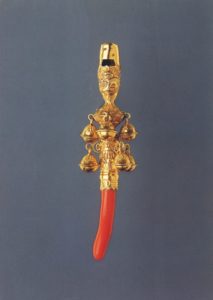

You may ask what rattles are doing in a museum devoted to the art of the book. Over twenty years ago the Bibliotheca Wittockiana acquired an astonishing, unusual, unique collection. Michel Wittock’s cousin Idès Cammaert donated to the museum some 5OO rattles, accumulated over thirty years of passionate collecting. This is the largest private collection of its kind. Most of the rattles were found in antique shops, junk shops or at auctions. During his many trips abroad, Idès Cammaert was always on the lookout for new items worthy of his collection. The result is a remarkable collection of rattles from all over the world covering a period of forty centuries.
The rattle is said to have been invented by Archytas of Tarentum (born around 440 BC). In truth, the origins of this charming artefact are lost to time, as it can undoubtedly be regarded as the oldest toy in the world. However, its uses go beyond that of a simple plaything intended to distract a child. The role attributed to the rattle is most often revealed in the choice of material used. Sometimes they are made of very ordinary materials such as dried fruit, pomegranates (whose dried seeds produce a rhythmical sound), or terracotta, and sometimes in very precious materials such as gold, rubies, silver, mother of pearl, ivory, coral or crystal.
All cultures in all eras have had rattles, and they should not be regarded as simple children’s toys. Often, they are used as dummies or teething rings. They may also indicate the wealth of the child’s family, and for thousands of years they have also been used as good-luck charms to protect babies against disease and sorcery.
